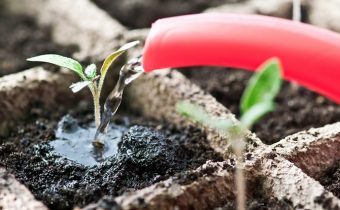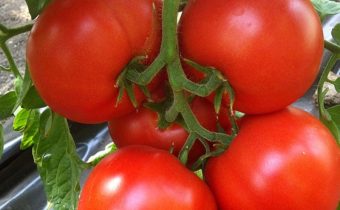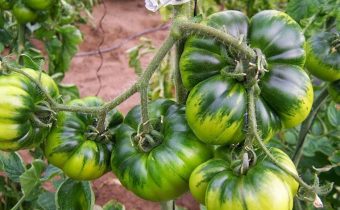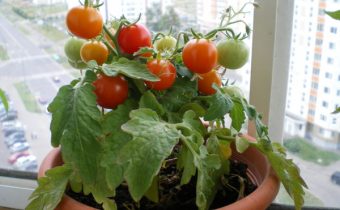Why tomatoes in the greenhouse do not form a fruit ovary
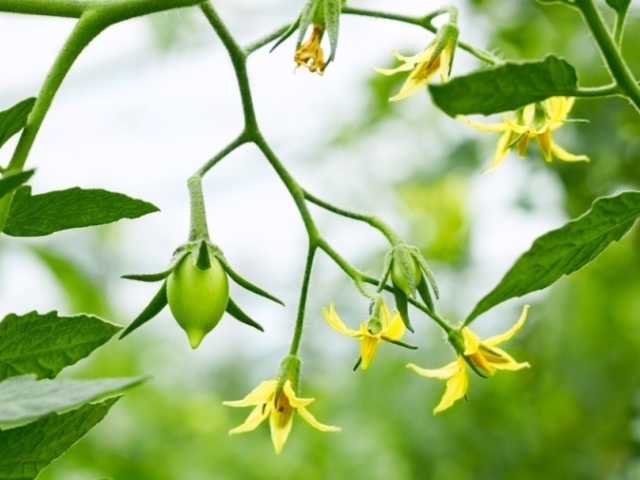
Tomatoes are a self-pollinating crop. Fruit setting occurs after fertilization of the pistil of the flower (female cells) with its own pollen (male cells). If for some reason this process is disrupted, the plant cannot form full-fledged fruits. As a result, "dummies" are formed, that is, hollow ovaries, they are further discarded by the plant as unnecessary. You can avoid such a problem on tomato bushes, knowing the reasons for the lack of fruit ovaries and how to eliminate them.
Fruit ovary formation
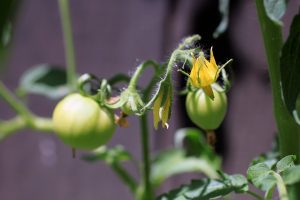 Tomatoes need special conditions so that they can successfully form fruit ovaries. In greenhouses do not always comply with the requirements that help the plant pollinate and bring harvest. Tomatoes in greenhouses can bloom thenonly under the following conditions:
Tomatoes need special conditions so that they can successfully form fruit ovaries. In greenhouses do not always comply with the requirements that help the plant pollinate and bring harvest. Tomatoes in greenhouses can bloom thenonly under the following conditions:
- the temperature in the greenhouse should not be higher or lower than +21, + 23 ° C;
- air humidity is not lower than 60%;
- watering the bushes produce always under the root;
- moistening is not frequent, but abundant (2 times a week, 3 liters of water);
- loosening - 1 time in 2 weeks;
- mulching with humus or peat - after each watering.
Attention!
Optimal conditions for growing tomatoes in the greenhouse due to scientific research. It can be difficult to do them, but it is necessary to obtain good yields of tomatoes.
Why there are no fruits on the bushes
The lack of fruit ovaries on the tomato bushes is explained not only by violations of the basic agrotechnical conditions, there are other reasons that cause poor fruit set.
Temperature changes in the greenhouse
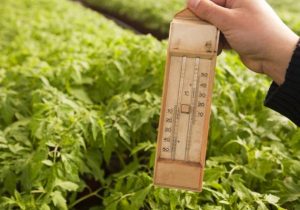 One of the main violations of tomato cultivation in the greenhouse are sharp temperature jumps air in the room.
One of the main violations of tomato cultivation in the greenhouse are sharp temperature jumps air in the room.
What to do in this case:
- in the greenhouse must be a thermometer to monitor the temperature;
- when it rises above the optimum of +23 degrees, it is necessary to conduct frequent airing;
- when lowered to + 20 ° and below, heating systems are equipped in the greenhouse: special wood-burning stoves, water or steam electric heaters.
Attention!
Cold water used when watering, negatively affects the formation of ovaries on tomatoes. Use only sun-warmed water. You can put a tank of water directly in the greenhouse, it will also help to increase the humidity of the air.
Moisture control
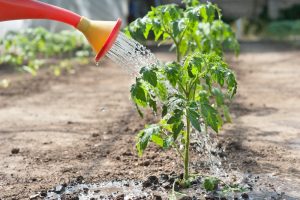 Another device that is needed in the greenhouse is an air humidity meter (moisture meter or hygrometer). With it, you can always set the actual percentage of moisture content in the air.
Another device that is needed in the greenhouse is an air humidity meter (moisture meter or hygrometer). With it, you can always set the actual percentage of moisture content in the air.
What to do if indoors greenhouses:
- Increased humidity (above 60%) may occur during or after watering the plants in the greenhouse, in this case it is recommended to ventilate the room for 1-2 hours after moistening the soil;
- reduced humidity (below 60%) is created in the greenhouse with long-term solar heating of the walls of the room;
Important!
When installing a greenhouse, choose a place for it, focusing from south to north, so that the narrow end part faces south, and the opposite side is not north. In this position, in the morning and in the evening the walls of the greenhouse will warm up equally, and at noon the roof will not have time to "heat up".
Artificial pollination with a lack of insects
In open beds, tomato flowers are pollinated by insects: bees, butterflies, beetles. Flying from one bush to another, they carry pollen on their bodies, helping her to get on the stigma of the pistil.
It is interesting!
One working bee visits more than 7 thousand flowers a day. Bumblebees almost do not work, maximum visits - 1-3 flowers, butterflies by activity take second place after the bees.
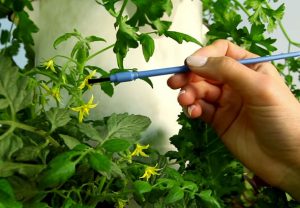 Insects rarely get into greenhouses, besides, the microclimate of the room is uncomfortable for them, they try to fly away immediately, they are not up to pollination. As a result, tomatoes bloom, but no one pollinates them. It is necessary to help the tomatoes - to carry out the procedure of artificial pollination.
Insects rarely get into greenhouses, besides, the microclimate of the room is uncomfortable for them, they try to fly away immediately, they are not up to pollination. As a result, tomatoes bloom, but no one pollinates them. It is necessary to help the tomatoes - to carry out the procedure of artificial pollination.
Methods of forced pollination of tomatoes:
- Mechanical - Volume BushShake the main stem lightly.
- Aerodynamic - electric fan turn on to medium power, and direct the air stream to the rows of bushes.
- The old proven method (the easiest) - use a soft brush to swipe possibly more colors.
- Modern way - the use of an electric toothbrush. Touching the flowers is not necessary, pollen will move away from the place of vibration and transferred to the pistil.
Need to know!
The flowers of tomatoes are fully opened, and the edges of the petals are bent down - this means that it is fertilized and ready to form the ovary.
Use of "correct" seeds
Beginning gardeners, trying to save on the purchase of seeds, procure their own seeds from previously grown tomatoes, not taking into account the classification of varieties and hybrids. Tomato seeds marked F1 on the packaging - this is a hybrid. It is impossible to collect seeds from such tomatoes.
Following tomato generation will be a hybrid second order, i.e. F2. Such seeds and seedlings from them are unpredictable, they do not save varietal quality, often all they can not bring the harvest, almost always shed empty ovaries.
Tip!
Buying on the market ready seedlings of tomatoes, ask the seller from what seeds it is grown. Harvested seeds themselves can be collected from F1 hybrids. Refuse to purchase such seedlings.
Proper feeding
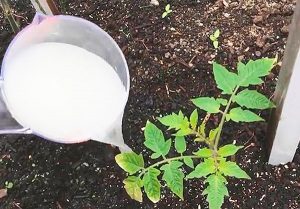 To stimulate the formation of fruit ovaries on tomatoes, you can use fertilizers. In greenhouses, plants often lack the minerals needed to form the fruit.
To stimulate the formation of fruit ovaries on tomatoes, you can use fertilizers. In greenhouses, plants often lack the minerals needed to form the fruit.
Stimulation drugs
With a lack of substances such as phosphorus, potassium or boron, tomatoes lack energy, ovaries form on them slowly and in small quantities. Gardeners with the experience of growing tomatoes are advised in this case to treat the bushes of tomatoes with a solution of boric acid, and to carry out root dressing with phosphorus-potassium fertilizers.
Excess fertilizer is harmful.
The tomato bushes in the greenhouse are actively increasing the green mass, and the ovaries are small - this may mean that the plant receives too many unnecessary fertilizers, especially nitrogen-containing ones. Correct the situation will help:
- temporary cessation of irrigation;
- airing the greenhouse to reduce humidity;
- removing leaves covering flowers from sunlight;
- spraying the bushes with phosphate fertilizer solutions;
- introduction under the root of phosphate and potassium.
Attention!
To determine that tomatoes are overfed with nitrogen fertilizers, can be on large leaves and weak inflorescences.
Spraying to increase yield
Processed tomatoes in order to increase the number of fruit ovaries with a solution of boric acid. Conduct this procedure 1-2 times with intervals of 10 days.
Boric acid
In a bucket of water warmed in the sun, you need to dissolve 10 g of powder, mix and filter. Pour the solution into the sprayer tank and thoroughly treat the tomato bushes.
Why do bushes get fat
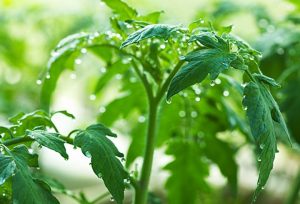 Gardeners, taking care of the harvest of tomatoes, bring into the soil a huge amount of organic matter and mineral fertilizers.This can not be done for one reason - nitrogen-containing fertilizers stimulate the rapid growth of stems and leaves, but they have a negative effect on fruit set. As a result, grows a strong green bush, and no fruit, then there are tomatoes in the greenhouse "fatten".
Gardeners, taking care of the harvest of tomatoes, bring into the soil a huge amount of organic matter and mineral fertilizers.This can not be done for one reason - nitrogen-containing fertilizers stimulate the rapid growth of stems and leaves, but they have a negative effect on fruit set. As a result, grows a strong green bush, and no fruit, then there are tomatoes in the greenhouse "fatten".
Nitrogen
The substance that causes the active growth of the plant, the rapid growth of green mass. It is found in large quantities in organic fertilizers: manure, compost. Lack or overdose in the soil has a negative impact on the yield of tomatoes.
Excess nitrogen
Excess nitrogen in the soil causes rapid growth of greenery, but slows down and even leads to the absence of fruit ovaries on tomatoes.
Recommendations: to bring organic matter in autumn or one month before planting seedlings within reasonable limits. On 1 square. m landings need no more than 1 bucket of manure or compost.
Lack of nitrogen
Nitrogen replenishes and regulates the energy balance of the plant. Its lack makes tomato bushes weak and unable to fruiting.
Recommendations: It is imperative to apply organic fertilizers in moderate doses (see above).
Measures
Stop the process of fattening tomatoes The following activities will help in the greenhouse:
- Do not water the tomato bushes for 7-10 days;
- in case of a large darkening of the tomatoes, remove the leaves blocking the inflorescences from the sun;
- adjust the temperature regime in the greenhouse (optimally from +21 to + 23 degrees);
- regular airing;
- apply artificial pollination;
- exclude top dressing with nitrogen-containing fertilizers;
- process seedlings with solutions of magnesium and potassium.
Tip!
In order to achieve high yields of tomatoes, do not forget - everything should be in moderation. Observe all agrotechnical requirements for growing tomatoes in greenhouses.
Forming a bush
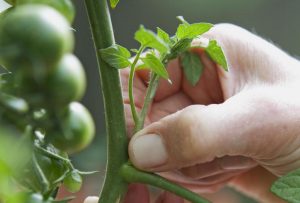 One of the additional measures for more successful fruit set is the correct the formation of a tomato bush. It is necessary to leave one main stem on the tomato bush. As the stepsons are formed in time to remove them. Pasynki should not grow more than 5 cm, otherwise when they are removed you can severely injure the whole plant.
One of the additional measures for more successful fruit set is the correct the formation of a tomato bush. It is necessary to leave one main stem on the tomato bush. As the stepsons are formed in time to remove them. Pasynki should not grow more than 5 cm, otherwise when they are removed you can severely injure the whole plant.
Conclusion
Growing tomatoes in the greenhouse is not easy, but over time comes experience and skill. Enthusiastic gardeners with their patience and work will achieve high results. Their tomatoes in the greenhouse will not only bloom, but also bring a significant harvest.



